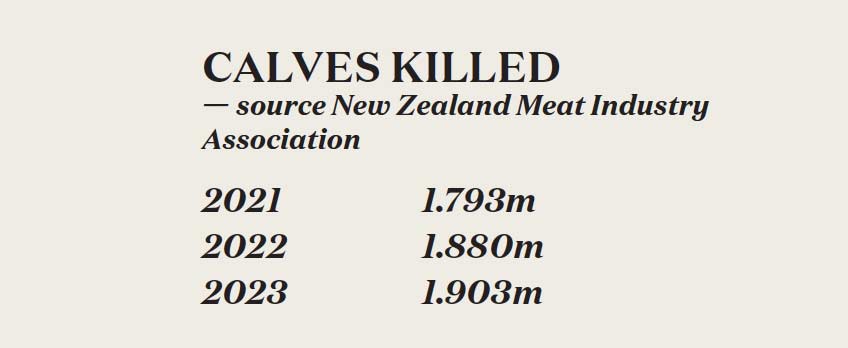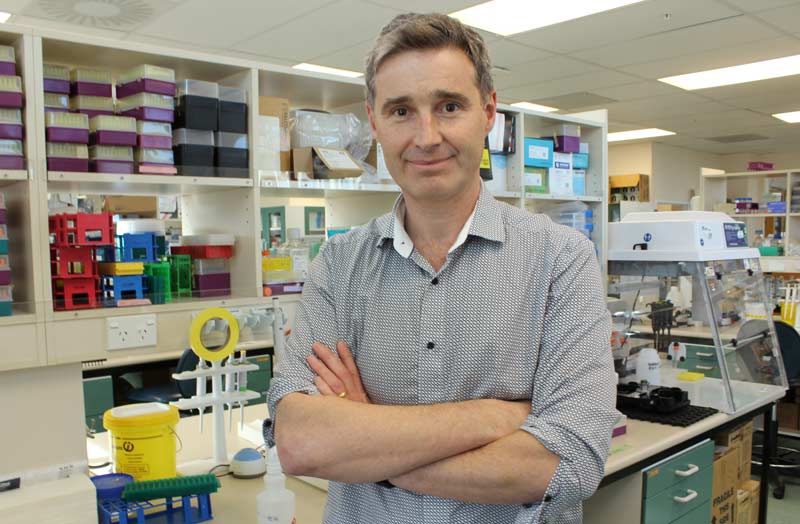

The price of milk
The slaughter of bobby calves — 1.9 million of them last year alone — is a sensitive topic for our dairy producers. The practice remains entrenched in New Zealand’s approach to dairy, and some of the byproducts are invaluable, reports Karen Trebilcock.
By Karen Trebilcock
In 2020, one New Zealand export was needed by the world more than any other.
It wasn’t our milk powder, our lamb or our logs. It wasn’t our mānuka honey, Zespri’s Gold Kiwifruit, computer games or Cloudy Bay’s Sauvignon Blanc found, it seems, on almost every international supermarket shelf, although those in lockdown certainly increased our wine exports that year.
It was calf blood serum and it was needed because that’s what immunologists throughout the world used to develop some Covid vaccines.
Serum is the liquid component of blood after it has been clotted. For the product exported from New Zealand, the blood mostly comes from almost two million dairy calves, known as bobbies, slaughtered each year when they are between four days and several weeks old.
Killing days-old calves in such huge numbers is done only in New Zealand. And the numbers each year are continuing upwards, even though dairy cow numbers are decreasing.
University of Otago Immunology Professor and Director of the Webster Centre for Infectious Diseases James Ussher says bovine blood serum — used in cell cultures — enabled the research which led to the development of a Covid vaccine he has been working on with the Vaccine Alliance Aotearoa New Zealand — Ohu Kaupare Huaketo (VAANZ) which will be ready for clinical trials this year.
Although most of us have been jabbed and jabbed again with the Pfizer vaccine, Ussher says there is a need for ongoing vaccine development.
“We still need better Covid-19 vaccines and we think ours may have some advantages over those currently in use.”
Using serum from animals is nothing new. The polio vaccine was one of the first back in the 1950s, winning three scientists the Nobel Prize for Physiology.
“Human serum is very expensive and hard to get in sufficient quantities so most labs use bovine serum,” Ussher says. It comes in half-litre bottles. “Most of the biomedical research done throughout the world depends on it.”
Bovine blood serum from New Zealand, with our low disease status, is sought after. The Meat Industry Association’s 2023 annual report shows exports of blood products and glands from all animals processed were worth $264 million in 2022/23, an increase of 24 per cent on the previous year.
The University of Otago, where Ussher works, has no idea how much it uses, although the Deputy Vice-Chancellor, research and enterprise, Professor Richard Blaikie, says the biological products derived from bovine blood are used in research throughout the university in cell culture, histology and imaging.
“In terms of quantities, that would be very difficult to determine, since these products are frequently components of test kits of varying volumes and concentrations.”
It’s not only their blood that puts a price on our bobby calves. In a report written under the Kellogg rural leadership programme in July 2021, Greg Hamill, who worked for dairy genetics company LIC found every part of the animal was used. While the meat graces the best restaurant tables in the world, and also our cats’ food bowls, the calves also provide products as diverse as perfume and pharmaceuticals to glue and biscuits.
That’s right — even baked goods can contain an ingredient sourced from a bobby calf. Lipase, an enzyme extracted from the glands at the base of the calf ’s tongue, is used to help bread, biscuits and cakes stay fresher for longer, reducing food wastage.
European cheese makers, with protected geographical status in European law, source rennet from New Zealand as the synthetic alternative just doesn’t cut it. Rennet is made from the fourth stomach, the vell, of a calf and almost every calf slaughtered in New Zealand has the vell removed for processing into rennet which is exported.
“It seems ironic to me that the consumers in international countries like China or Europe that want dairy and meat products from countries that do not support a bobby-calf industry, are the same countries/consumers that will pay premiums for the co-products that are generated from the bobby calf,” Hamill says in his Kellogg conclusion, which also calls for an industry review.

So why does New Zealand kill so many calves? Dairy cows have been bred for hundreds of years to produce milk. The main dairy breeds are friesian (the tall black and white cows) and jersey (the brown, shorter cows). Because we are Kiwis and do this sort of thing, we’ve also crossed the two so we get the best out of both breeds. They’re the all black cows you see in paddocks.
Beef breeds have been bred to grow muscle, or meat, as quickly as possible. The boys do it better than the girls. A well-bred beef animal will be ready for processing at 18 months, only having to be wintered once.
Our main beef breeds are the black angus and the brown (with white heads) hereford. We also farm charolais (white), simmental (brown and white) and lots of others, with the prized Japanese wagyu a recent addition.
For a cow to produce milk it must first calve. Our dairy cows have not been bred to be mothers. They are bred for good feet, udder attachment, temperament. It’s not unusual for cows to steal each other’s calves, abandon them or refuse to feed them. Because of this, most dairy calves are removed within 24 hours of birth simply to make sure they survive.
Unlike dairy farmers elsewhere, New Zealand’s mainly feed cows pasture, so cows are only milking when the grass is growing (something former Fonterra chief executive Theo Spierings from the Netherlands confessed he didn’t know when he arrived to take up the job). Calves are generally born from the end of winter, July through to October, and when there is lush spring grass (when you mow your lawns the most) the cows hit peak milk production. By the start of June the following year, it’s all over and the cows have the winter off. They’re pregnant with another calf to start the milking season again. Cows have the same gestation length as humans — nine months. There are a few autumn-calving herds, mainly in the North Island.

University of Otago Immunology Professor and Director of the Webster Centre for Infectious Diseases James Ussher.
Most of our dairy cows are artificially inseminated (AI) which means farmers can decide what type of calf each cow has. They can use dairy or beef breeds, and sexed semen so they can choose whether the calf will be male or female. AI not only allows the very best genetics to be used over the most animals but it also minimises the number of bulls that have to be on dairy farms to mate cows naturally. Bulls eat grass that could be made into milk but are also a safety hazard to farm staff and, if you have ever watched a large bull and cow in the sex act, you will know it’s a hazard to cows as well.
Our 4.8 million dairy cows have one calf (very occasionally twins) every year and because dairy cows get old and must be replaced, about 20 per cent of them (of course only females, known as heifers) are kept and reared to go into the milking herd as two year olds. The rest have a very different future.
It’s that future — and what Fonterra’s customers think about it — that our largest milk processor has started to worry about.


